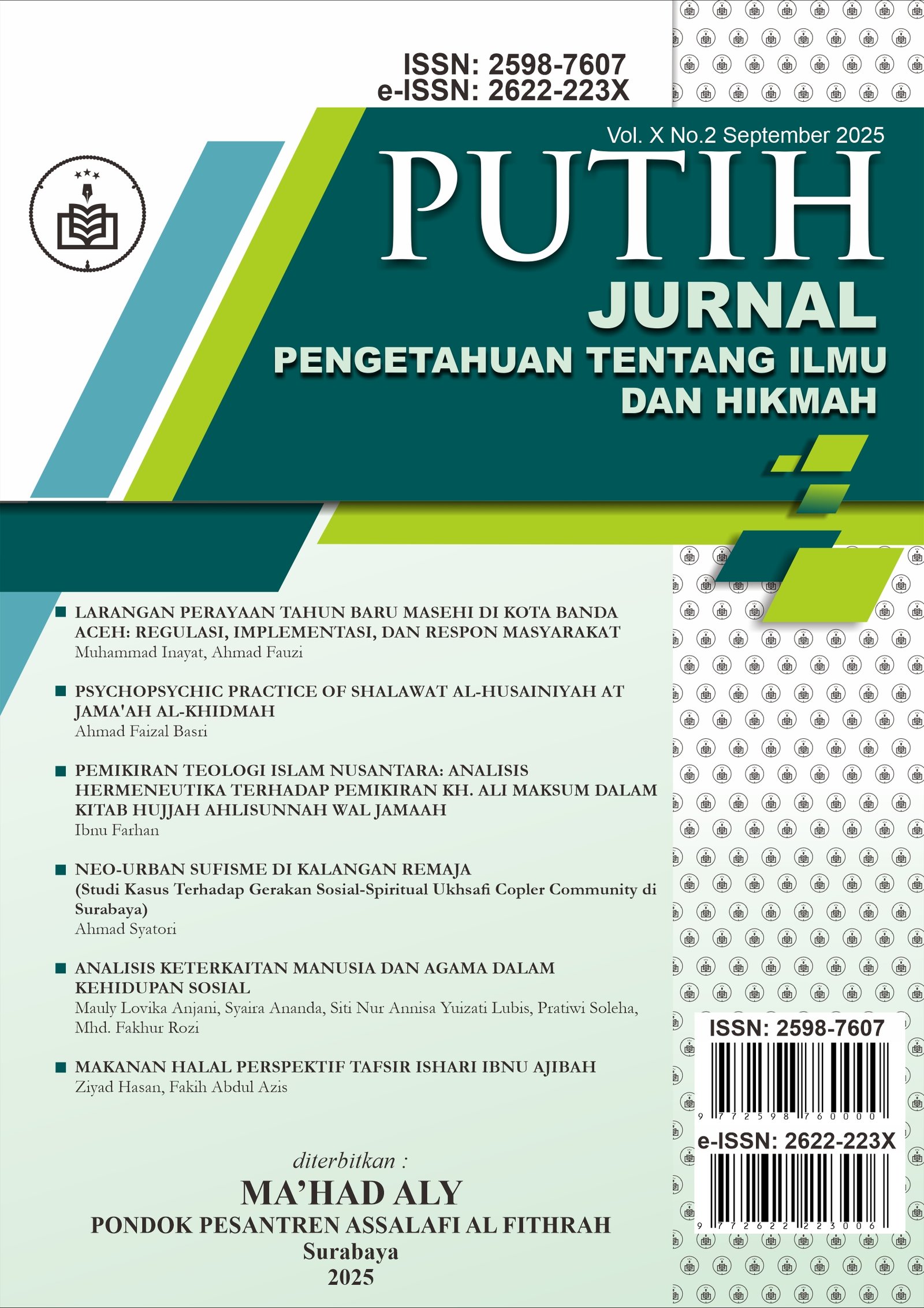Neo-Urban Sufisme di Kalangan Remaja
Studi Kasus Terhadap Gerakan Sosial-Spiritual Ukhsafi Copler Community di Surabaya
DOI:
https://doi.org/10.51498/putih.2025.10(2).65-81Keywords:
Ukhsafi Copler Community (UCC), Neo-Urban Sufism, TeenagersAbstract
The emergence of various expressions of religious activities that have grown in the midst of urban life can be interpreted as a form of increased religiosity in the new model movement. When viewed from the perspective of the current phenomenon of urban Sufism, it is clear that there are majelis dzikir (prayer gatherings) developing in every corner of the city. These gatherings are activities organised by a group of young people and teenagers popularly known as the Ukhsafi Copler Community (UCC). The purpose of this study is to explore and reveal the socio-spiritual phenomena in the important role of UCC activities in relation to the problems of Neo-Urban Sufism among young people and teenagers in the city of Surabaya. The research method used in this study is qualitative research with a phenomenological approach, which is the science of the development of human consciousness and self-awareness. The technique used to determine the informants in this study was purposive, whereby the researcher selected various subjects based on specific reasons. This study found negative symptoms, attitudes and behaviours among young people and teenagers, including criminal acts and juvenile delinquency. The formulation of the problem regarding the origins and definition, characteristics of the UUC and its various activities was an important part of this study. The socio-spiritual movement in the activities carried out by the Ukhsafi Copler Community can have a very positive and significant impact, which is noted in the conclusions of this study.
Downloads
References
A. Mujib, Biografi KH. Ahmad Asrori Al-Ishaqi (Surabaya: Darul Ulum, 1995), 47-50.
A. Azra, Islam Nusantara: Dinamika dan Tantangan (Jakarta: Gramedia, 2016), 102-105.
M.Taufiqur Rahman, “Strategi Dakwah Copler Community pada Anak-Anak Muda di Wilayah Kecamatan Waru Kabupaten Sidoarjo” (Skripsi, UIN Sunan Ampel, Surabaya, 2019). 15.
A. Zamhari, “Dinamika Majelis Dzikir di Era Modern” (Surabaya: UIN Press, 2020), 12-15.
Agus Farid, Wawancara, Surabaya, 25 Juni 2023.
Alwi Shihab, Membendung Arus: Respon Gerakan Muhammadiyah terhadap Penetrasi Misi Kristen di Indonesia (Bandung: Mizan, 1998), 212
Bethany Walker, “Rural Sufism as Channels of Charity in Nineteenth-Century Jordan”, dalam Interpreting Welfare and Relief in the Middle East, ed. Nefissa Naguib and Inger Marie Okkenhaug (Oxford: Brill, 2008), 34.
Burhan Bungin, Penelitian Kualitatif: Komunikasi, Ekonomi, Kebijakan Publik, dan Ilmu Sosial Lainnya (Jakarta: Kencana, 2011), 35
H. Ahmad, "Sufisme Dalam Larangan" (Jakarta: Pustaka Islam, 2019) 34-35.
H. Nasution, Pembaharuan Dalam Islam: Sejarah Pemikiran dan Gerakan, (Jakarta: Bulan Bintang, 1985), 56-58.
Ikrimah, Sejarah Perkembangan Islam (Jakarta: Pustaka Ilmu, 2023), 50.
Lexy J. Moleong, , Metodologi Penelitian Kualitatif (Bandung: PT Remaja Rosdakarya, 2002), 10.
Azyumardi Azra, Islam Substantif (Bandung: Mizan, 2002), 48.
Lilis Andarwati, “Sufisme Perkotaan dan Pedesaan di Era Modernisasi dan Sekularisasi”, Universum: Jurnal KeIslaman dan Kebudayaan 10, no. 1 (2016), 48.
Marshall G. S. Hodgson, The Expansion of Islam in the Middle Periods (Chicago: University of Chicago Press, 1991), 98.
Moh. Nazir, Metode Penelitian (Jakarta: Ghalia Indonesia, 1988),186-187.
Muhammad Yusuf, Makbulnya Zikir dan Doa (Jakarta: Bhuana Ilmu Populer, 2014), 21. Wulandari, Nadiya Safitri, dan Tasmuji. “Urban Sufisme di Surabaya: Studi Fenomenologis Peran dan Kontribusi Kelompok Copler Community di Surabaya”. Journal of Ushuluddin and Islamic Thought 1, no. 1 (2023). https://doi.org/10.15642/juit.2023.1.1.56-71.
Nasution, Metode Penelitian Naturalistik Kualitatif (Bandung: Tarsito, 2003), 52.
Nurcholish Madjid, Islam, Doktrin dan Peradaban (Jakarta: Yayasan Wakaf Paramadina, 1992), 126.
Patricia Crone, Medieval Islamic Political Thought (Édinburgh: Edinburgh University Press, 2004), 16.
R. Bogdan dan SK. Biklen, Penelitian Kualitatif untuk Pendidikan (Jakarta: Indeks, 1998), 67.
Sugiyono, Metode Penelitian Kuantitatif, Kualitatif dan R&D (Bandung: Alfabeta, 2016), 73.
Sugiyono, Metode Penelitian Pendidikan (Bandung: Alfabeta, 2017), 218.
Tholhatul Choir, Ahwan Fanani, dan Abdul Basith Junaidi, Islam dalam Berbagai Pembacaan Kontemporer (Yogyakarta: Pustaka Pelajar, 2009), 55
WM. Abdul Hadi, Tasawuf Yang Hidup (Yogyakarta: Bentang Pustaka, 2001), 67-69. A. Shihab, Islam Inklusif: Menuju Dialog Teologi (Bandung: Mizan, 1997), 89-91.
Tsania Fani Ikrimah, “Sejarah Perkembangan Tarekat Qadiriyah wa Naqsyabandiyah di Pondok Pesantren Assalafi Al-Fithrah Kedinding Surabaya Tahun 1985-2018” (Skripsi, UIN Sunan Ampel, Surabaya, 2019), 50.
M. Taufikur Rachman al-Faridzi, “Kepemimpinan Agus Muhammad Nidhom Asrori bagi Komunitas Copler di Pondok Pesantren Roudlotul Ulum Cemengkalang Sidoarjo” (Skripsi, UIN Sunan Ampel Surabaya, 2019), 35.
















